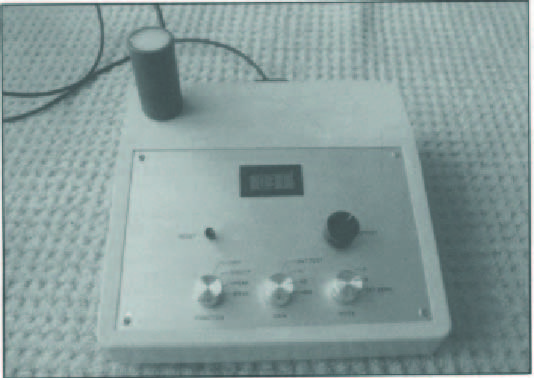Introduction
The project seemed like a distraction but was to open doors to projects of future scope. There had always been encouragement in the family home to make things – plaster of Paris moulds of scottie dogs and ladies with large dresses. There was undoubted skill here to add just enough water to the white powder and manipulate the partially filled mould to remove air bubbles. And wood turning – celebrated in the famous match holder in the shape of a thistle (end image).
My father’s generation was adept at making crystal radio receivers – where a family could be entertained by listening to such a set which operated only on the energy the crystal set was able to pick up from the ether. A rather large aerial, however, might be required. There was a certain degree of rivalry between crystal set makers as to who could produce the loudest set. For many years radio receivers were typically available in kit form rather than in working sets and my father would supply radios to various family members and neighbours.
A key phase I recall of developing electronic skills was working with a Philips electronics kit. This Christmas gift still reflected a transistor based electronic universe though the range of experiments was subtle and diverse and included an analogue computer. The explosion of electronic development, however, was to take place during the 1970’s where instead of utilising individual transistors to laboriously design circuits, chips could be used which incorporated relatively large number of semiconductor devices. To then design circuits was a process of utilising individual ‘black boxes’ of semiconductor chips. There were plenty of readable text books to explain how everyone could be an electronics designer. Also, the chips were affordable – reflecting the vast scale of their manufacture.
There was also awareness of the potential of such technology as a tool for science education and slowly some cogs and wheels turned in this direction in my mind. Central to this was the use of a software package (EASYPC) to design a printed circuit board to accommodate the various elements of such a system which was based on circuits to sense specific physical parameters. I do recall, however, as a teenager trying to etch copper track circuits using Ferric Chloride (now a banned substance). The sensor items included light, ultra violet radiation, sound level, magnetic field, temperature and piezo-electric sensor. Associated with each sensor system was a set of around 50 documented experiments – each with their associated worksheet. This was in development long before the ascendancy of the Internet- though on reflection with access to such resources the development time of the project could have been somewhat reduced.
There were milestones along the way – an article published in ‘IET’ – ‘All about silicon playground’ (still on-line) – brought some limited enquiries from technology teachers who were probably looking for bargain basement prices which were not really on offer. Interest was shown by a technology company with an address in Baker Street, London, though I was perhaps careless in nurturing potential product development in this regard. Sherlock Homes would, I surmise, have done much better. I had always thought that scientific application and knowledge was the key factor in successful commercial ventures and that this alone would lead to success. Smart commercial insight I now realise is an essential factor. Also, I should have been more resourceful in trying to obtain funding for development/production.
I am mindful, however, that the scope of the project remains and perhaps there is a clearer perception of the intrinsic value of ‘Silicon Playground’ wherein a young enquiring mind can develop latent gifts of curiosity and the means to develop an understanding of the world around them. The question is whether to replicate the core system of the mid 1990’s or make a leap forward with possible utilisation of smartphone technology. I would certainly, however, use Kindle Direct Publishing (KDP) to produce the instruction manual and worksheets. I have used KDP to recently publish ‘How to talk to your robot dog’ within Amazon and which was a smooth process – except that I did not market the title adequately. Slowly the gears and cogs are turning again at a moment in time when memory storage cards of 128 GBytes capacity cost only £20.00, though I can recall a time in the 1970’s when a 1 Mbyte disk on a minicomputer would then cost £10k and a typical lunch would cost 30 pence.
Some Technical Details
The figure below shows an image of the prototype system.

Details of controls are:-
FUNCTION (clockwise)
OFF – disconnect from battery
DIRECT – display indicates signal from sensor circuit
+ PEAK – display holds peak positive value sensed
— PEAK-display holds peak negative value sensed
GAIN (clockwise)
BAT CHECK – indicates battery voltages on display
xl – gain of 1; maximum scale 199.9
x 10 – gain of 10; maximum scale 19.99
x 100 – gain of 100; maximum scale1.999
MODE (clockwise)
A-sound circuit ‘FAST’ response; Hall
circuit static fields
B – sound circuit ‘SLOW response; Hall
circuit alternating fields
SET ZERO – inputs true zero signal to display unit
RESET
Sets ‘held’ voltage to zero.
OFFSET
To set zero.
The table below indicates the quantities and units measured.
| Quantity (units) | Device used as sensor |
| Light (klux) | Eye response photodiode |
| Ultra Violet ‘A’ (mW/cm2) | Photodiode with UVA filter |
| magnetic field (mT) | Hall sensor |
| temperature (C) | Linear semiconductor device |
| Piezo-electric effect (volt) | PVDF sensor |
| Sound (dB(A)) | electret microphone |
The Clarkson Match Holder
For posterity – this is one of the surviving items…
